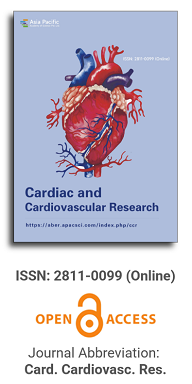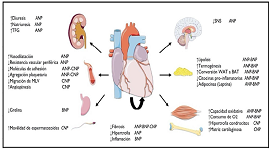
Asia Pacific Academy of Science Pte. Ltd. (APACSCI) specializes in international journal publishing. APACSCI adopts the open access publishing model and provides an important communication bridge for academic groups whose interest fields include engineering, technology, medicine, computer, mathematics, agriculture and forestry, and environment.

The vulnerable or high-risk plaque and coronary thrombotic events
Vol 5, Issue 2, 2024
Download PDF
Abstract
Atherosclerosis is a chronic systemic vascular disease known to start early in life. It progresses with age and other risk factors. When involving the coronary vessels, it may present gradually or acutely as anginal pain or as acute coronary syndrome. For decades this acute presentation has been studied. Certain plaque characteristics were identified to be the culprit for those acute coronary syndromes. Relentless efforts to increase the sensitivity of screening for these vulnerable plaques have been developed. The goal is to create a preemptive intervention strategy with effective medical or percutaneous therapies. In this article, we explore the different modalities for early identification and management of those vulnerable or high-risk plaques.
Keywords
References
- Davies MJ, Thomas A. Thrombosis and Acute Coronary-Artery Lesions in Sudden Cardiac Ischemic Death. The New England Journal Medicine. 1984; 310(18): 1137–1140. doi: 10.1056/NEJM198405033101801
- DeWood MA, Spores J, Notske R, et al. Prevalence of total coronary occlusion during the early hours of transmural myocardial infarction. The New England Journal Medicine. 1980; 303(16): 897–902. doi: 10.1056/NEJM198010163031601
- Ambrose JA, Sharma AV. Identifying and Treating Vulnerable Atherosclerotic Plaques. The American journal of cardiology. 2023; 205: 214–222. doi: 10.1016/j.amjcard.2023.07.121
- Chapman I. Morphogenesis of occluding coronary artery thrombosis. Archives of pathology. 1965; 80: 256-261.
- Virmani R, Kolodgie FD, Burke AP, et al. Lessons From Sudden Coronary Death: A Comprehensive Morphological Classification Scheme for Atherosclerotic Lesions. Arteriosclerosis, Thrombosis, and Vascular Biology. 2000; 20(5): 1262–1275. doi: 10.1161/01.ATV.20.5.1262
- Lubbers M, Dedic A, Coenen A, et al. Calcium imaging and selective computed tomography angiography in comparison to functional testing for suspected coronary artery disease: the multicentre, randomized CRESCENT trial. European Heart Journal. 2016; 37(15): 1232–1243. doi: 10.1093/eurheartj/ehv700
- Kashiwagi M, Tanaka A, Kitabata H, et al. Feasibility of Noninvasive Assessment of Thin-Cap Fibroatheroma by Multidetector Computed Tomography. JACC Cardiovasc Imaging. 2009; 2(12): 1412–1419. doi: 10.1016/j.jcmg.2009.09.012
- Motoyama S, Kondo T, Sarai M, et al. Multislice Computed Tomographic Characteristics of Coronary Lesions in Acute Coronary Syndromes. Journal of the American College of Cardiology. 2007; 50(4): 319–326. doi: 10.1016/j.jacc.2007.03.044
- Motoyama S, Sarai M, Harigaya H, et al. Computed Tomographic Angiography Characteristics of Atherosclerotic Plaques Subsequently Resulting in Acute Coronary Syndrome. Journal of the American College of Cardiology. 2009; 54(1): 49–57. doi: 10.1016/j.jacc.2009.02.068
- Nakanishi K, Fukuda S, Shimada K, et al. Non-obstructive low attenuation coronary plaque predicts three-year acute coronary syndrome events in patients with hypertension: Multidetector computed tomographic study. Journal of cardiology. 2012; 59(2): 167–75. doi: 10.1016/j.jjcc.2011.11.010
- Ferencik M, Mayrhofer T, Bittner DO, et al. Use of High-Risk Coronary Atherosclerotic Plaque Detection for Risk Stratification of Patients With Stable Chest Pain. JAMA Cardiology. 2018; 3(2): 144. doi: 10.1001/jamacardio.2017.4973
- Williams MC, Moss AJ, Dweck M, et al. Coronary Artery Plaque Characteristics Associated With Adverse Outcomes in the SCOT-HEART Study. Journal of the American College of Cardiology. 2019; 73(3): 291–301. doi: 10.1016/j.jacc.2018.10.066
- Chang HJ, Lin FY, Lee SE, et al. Coronary Atherosclerotic Precursors of Acute Coronary Syndromes. Journal of the American College of Cardiology. 2018; 71(22): 2511–2522. doi: 10.1016/j.jacc.2018.02.079
- Tzolos E, Williams MC, McElhinney P, et al. Pericoronary Adipose Tissue Attenuation, Low-Attenuation Plaque Burden, and 5-Year Risk of Myocardial Infarction. JACC Cardiovasc Imaging. 2022; 15(6): 1078–1088. doi: 10.1016/j.jcmg.2022.02.004
- Kheiri B, Simpson TF, Osman M, et al. Computed Tomography vs Invasive Coronary Angiography in Patients With Suspected Coronary Artery Disease: A Meta-Analysis. JACC Cardiovasc Imaging. 2022; 15(12): 2147–2149. doi: 10.1016/j.jcmg.2022.06.003
- Bourantas CV, Tenekecioglu E, Radu M, et al. State of the art: role of intravascular imaging in the evolution of percutaneous coronary intervention—a 30-year review. EuroIntervention: journal of EuroPCR in collaboration with the Working Group on Interventional Cardiology of the European Society of Cardiology. 2017; 13(6): 644–653. doi: 10.4244/EIJ-D-17-00471
- Uchida Y, Nakamura F, Tomaru T, et al. Prediction of acute coronary syndromes by percutaneous coronary angioscopy in patients with stable angina. American heart journal. 1995; 130(2): 195–203. doi: 10.1016/0002-8703(95)90429-8
- Stone GW, Maehara A, Lansky AJ, et al. A prospective natural-history study of coronary atherosclerosis. The New England journal of medicine. 2011; 364(3): 226–235. doi: 10.1056/NEJMoa1002358
- Gerbaud E, Weisz G, Tanaka A, et al. Plaque burden can be assessed using intravascular optical coherence tomography and a dedicated automated processing algorithm: a comparison study with intravascular ultrasound. European Heart Journal - Cardiovascular Imaging. 2020; 21(6): 640–652. doi: 10.1093/ehjci/jez185
- Erlinge D, Maehara A, Ben-Yehuda O, et al. Identification of vulnerable plaques and patients by intracoronary near-infrared spectroscopy and ultrasound (PROSPECT II): a prospective natural history study. Lancet (London, England). 2021; 397(10278): 985–995. doi: 10.1016/S0140-6736(21)00249-X
- Waksman R, Di Mario C, Torguson R, et al. Identification of patients and plaques vulnerable to future coronary events with near-infrared spectroscopy intravascular ultrasound imaging: a prospective, cohort study. The Lancet. 2019; 394(10209): 1629-1637. doi: 10.1016/S0140-6736(19)31794-5
- Prati F, Romagnoli E, Gatto L, et al. Relationship between coronary plaque morphology of the left anterior descending artery and 12 months clinical outcome: the CLIMA study. European heart journal. 2020; 41(3): 383–391. doi: 10.1093/eurheartj/ehz520
- Kubo T, Ino Y, Mintz GS, et al. Optical coherence tomography detection of vulnerable plaques at high risk of developing acute coronary syndrome. European heart journal. Cardiovascular Imaging. 2021. doi: 10.1093/ehjci/jeab028
- Kedhi E, Berta B, Roleder T, et al. Thin-cap fibroatheroma predicts clinical events in diabetic patients with normal fractional flow reserve: the COMBINE OCT-FFR trial. European heart journal. 2021; 42(45): 4671–4679. doi: 10.1093/eurheartj/ehab433
- Park SJ, Ahn JM, Kang DY, et al. Preventive percutaneous coronary intervention versus optimal medical therapy alone for the treatment of vulnerable atherosclerotic coronary plaques (PREVENT): a multicentre, open-label, randomised controlled trial. Lancet. 2024; 403(10438): 1753–1765. doi: 10.1016/S0140-6736(24)00413-6
- Prati F. Interventional strategy for non-culprit lesions with major vulnerability criteria at OCT in patients with ACS (INTERCLIMA). Available online: https://clinicaltrials.gov/study/NCT05027984 (accessed on 12 December 2024).
- Kedhi E. COMBINE-INTERVENE: COMBINEd Ischemia and Vulnerable Plaque Percutaneous INTERVENtion to Reduce Cardiovascular Events. Available online: https://diagramresearch.com/trials/combine-intervene/ (accessed on 3 November 2024).
- Stone GW, Maehara A, Ali ZA, et al. Percutaneous Coronary Intervention for Vulnerable Coronary Atherosclerotic Plaque. J Journal of the American College of Cardiology. 2020; 76(20): 2289–2301. doi: 10.1016/j.jacc.2020.09.547
- National Library of Medicine-National Center for Biotechnology Information. Intravascular Identification and Drug-Eluting Balloon Treatment of Vulnerable Lipid-Rich Plaques (DEBuT-LRP). Available online: https://clinicaltrials.gov/study/NCT04765956#collaborators-and-investigators (accessed on 3 November 2024).
- Komukai K, Kubo T, Kitabata H, et al. Effect of atorvastatin therapy on fibrous cap thickness in coronary atherosclerotic plaque as assessed by optical coherence tomography: the EASY-FIT study. Journal of the American College of Cardiology. 2014; 64(21): 2207–2217. doi: 10.1016/j.jacc.2014.08.045
- Nissen SE, Nicholls SJ, Sipahi I, et al. Effect of very high-intensity statin therapy on regression of coronary atherosclerosis: the ASTEROID trial. JAMA. 2006; 295(13): 1556–1565. doi: 10.1001/jama.295.13.jpc60002
- van Rosendael SE, van den Hoogen IJ, Lin FY, et al. Clinical and Coronary Plaque Predictors of Atherosclerotic Nonresponse to Statin Therapy. JACC Cardiovasc Imaging. 2023; 16(4): 495–504. doi: 10.1016/j.jcmg.2022.10.017
- Nissen SE, Tuzcu EM, Schoenhagen P, et al. Effect of intensive compared with moderate lipid-lowering therapy on progression of coronary atherosclerosis: a randomized controlled trial. JAMA. 2004; 291(9): 1071–1080. doi: 10.1001/jama.291.9.1071
- Nicholls SJ, Puri R, Anderson T, et al. Effect of Evolocumab on Progression of Coronary Disease in Statin-Treated Patients: The GLAGOV Randomized Clinical Trial. JAMA. 2016; 316(22): 2373–2384. doi: 10.1001/jama.2016.16951
- Nicholls SJ, Nissen SE, Prati F, et al. Assessing the impact of PCSK9 inhibition on coronary plaque phenotype with optical coherence tomography: rationale and design of the randomized, placebo-controlled HUYGENS study. Cardiovascular diagnosis and therapy. 2021; 11(1): 120–129. doi: 10.21037/cdt-20-684
- Puchner SB, Liu T, Mayrhofer T, et al. High-risk plaque detected on coronary CT angiography predicts acute coronary syndromes independent of significant stenosis in acute chest pain: results from the ROMICAT-II trial. Journal of the American College of Cardiology. 2014; 64(7): 684–692. doi: 10.1016/j.jacc.2014.05.039
- Budoff MJ, Kinninger A, Gransar H, et al. When Does a Calcium Score Equate to Secondary Prevention?: Insights From the Multinational CONFIRM Registry. JACC Cardiovasc Imaging. 2023; 16(9): 1181–1189. doi: 10.1016/j.jcmg.2023.03.008
- Puri R, Nicholls SJ, Shao M, et al. Impact of statins on serial coronary calcification during atheroma progression and regression. American College of Cardiology. 2015; 65(13): 1273–1282. doi: 10.1016/j.jacc.2015.01.036
- Fernández-Friera L, Peñalvo JL, Fernández-Ortiz A, et al. Prevalence, Vascular Distribution, and Multiterritorial Extent of Subclinical Atherosclerosis in a Middle-Aged Cohort: The PESA (Progression of Early Subclinical Atherosclerosis) Study. Circulation. 2015; 131(24): 2104–2113. doi: 10.1161/CIRCULATIONAHA.114.014310
- Devesa A, Ibanez B, Malick WA, et al. Primary Prevention of Subclinical Atherosclerosis in Young Adults: JACC Review Topic of the Week. Journal of the American College of Cardiology. 2023; 82(22): 2152–2162. doi: 10.1016/j.jacc.2023.09.817
Supporting Agencies
Copyright (c) 2024 John A. Ambrose, Asseel Albayati
License URL: https://creativecommons.org/licenses/by/4.0/

This site is licensed under a Creative Commons Attribution 4.0 International License (CC BY 4.0).

Prof. Prakash Deedwania
University of California,
San Francisco, United States




